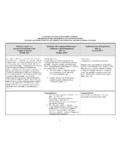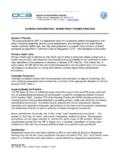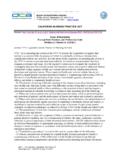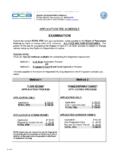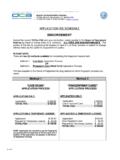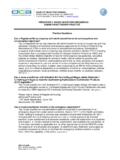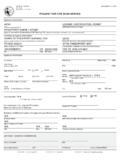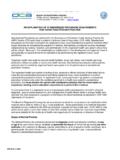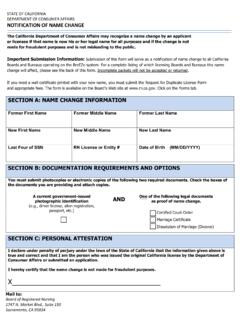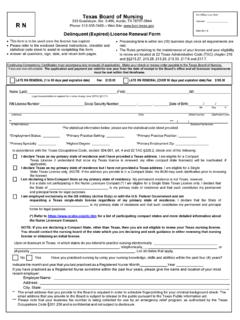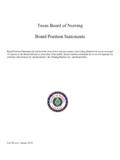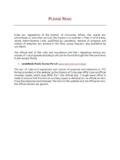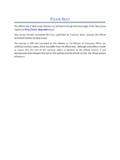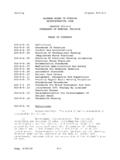Transcription of BUSINESS, CONSUMER SERVICES, AND HOUSING …
1 NPR-B-03 06/1995 AN EXPLANATION OF SCOPE OF RN PRACTICE INCLUDING STANDARDIZED PROCEDURES REV. 07/1997, 01/2011 1 BUSINESS, CONSUMER SERVICES AND HOUSING AGENCY GAVIN NEWSOM, GOVERNOR board OF registered nursing PO BOX 944210, Sacramento, CA 94244-2100 P (916) 322-3350 | TTY (800) 326-2297 | AN EXPLANATION OF THE SCOPE OF RN PRACTICE INCLUDING STANDARDIZED PROCEDURES The Legislature, in its 1973-74 session, amended Section 2725 of the nursing Practice Act (NPA), amplifying the role of the registered nurse and outlining activities which comprise the practice of nursing . LEGISLATIVE INTENT The Legislature recognized that nursing is a dynamic field, continually evolving to include more sophisticated patient care activities.
2 It declared its intent to recognize the existence of overlapping functions between physicians and registered nurses and to permit additional such sharing and to provide clear legal authority for those functions and procedures which have common acceptance and usage. Prior to this, nurses had been educated to assume advanced roles, and demonstration projects had proven their ability to do this safely and effectively. Thus, legal amplification of the role paralleled the readiness of nurses to assume the role and recognized that many were already functioning in an expanded role. SCOPES OF PRACTICE A knowledge of the respective scopes of practice of registered nurses and physicians is important in determining which activities overlap medical practice and therefore require standardized procedures.
3 Failure to distinguish nursing practice from medical practice may result in the limitation of the registered nurse's practice and the development of unnecessary standardized procedures. registered nurses are cautioned not to confuse nursing policies and procedures with standardized procedures. 1. Scope of registered nursing Practice The activities comprising the practice of nursing are outlined in the nursing Practice Act, Business and Professions Code Section 2725. A broad, all inclusive definition states that the practice of nursing means those functions, including basic health care, which help people cope with difficulties in daily living which are associated with their actual or potential health or illness problems, or the treatment thereof, which require a substantial amount of scientific knowledge or technical skill.
4 In Section 2725(a), the Legislature expressly declared its intent to provide clear legal authority for functions and procedures which have common acceptance and usage. registered nurses must recognize that the application of nursing process functions is common nursing practice which does not require a standardized procedure. nursing practice is divided into three types of functions, which are described below. A. Independent Functions Subsection (b)(1) of Section 2725, authorizes direct and indirect patient care services that insure the safety, comfort, personal hygiene and protection of patients, and the performance of disease prevention and restorative measures.
5 Indirect services include delegation and supervision of patient care activities performed by subordinates. Subsection (b)(3) of Section 2725, specifies that the performance of skin tests, immunization techniques and withdrawal of human blood from veins and arteries is included in the practice of nursing . NPR-B-03 06/1995 AN EXPLANATION OF SCOPE OF RN PRACTICE INCLUDING STANDARDIZED PROCEDURES REV. 07/1997, 01/2011 2 Subsection (b)(4) of Section 2725, authorizes observation of signs and symptoms of illness, reactions to treatment, general behavior, or general physical condition and determination of whether these exhibit abnormal characteristics; and based on this determination, the implementation of appropriate reporting or referral, or the initiation of emergency procedures.
6 These independent nursing functions have long been an important focus of nursing education, and an implied responsibility of the registered nurse. B. Dependent Functions Subsection (b)(2) of Section 2725, authorizes direct and indirect patient care services, including, but not limited to, the administration of medications and therapeutic agents necessary to implement a treatment, disease prevention, or rehabilitative regimen ordered by and within the scope of licensure of a physician, dentist, podiatrist or clinical psychologist. C. Interdependent Functions Subsection (b)(4) of Section 2725, authorizes the nurse to implement appropriate standardized procedures or changes in treatment regimen in accordance with standardized procedures after observing signs and symptoms of illness, reactions to treatment, general behavior, or general physical condition, and determining that these exhibit abnormal characteristics.
7 These activities overlap the practice of medicine and may require adherence to a standardized procedure when it is the nurse who determines that they are to be undertaken. 2. Scope of Medical Practice The Medical Practice Act authorizes physicians to diagnose mental and physical conditions, to use drugs in or upon human beings, to sever or penetrate the tissues of human beings and to use other methods in the treatment of diseases, injuries, deformities or other physical or mental conditions. As a general guide, the performance of any of these by a registered nurse requires a standardized procedure; however, activities within each of these categories have already become common nursing practice and therefore do not require standardized procedures; for example, the administration of medication by injection requires penetration of human tissue, and registered nurses have performed this function through the years.
8 In Section 2725(a), the Legislature referred to the dynamic quality of the nursing profession. This means, among other things, that some functions which today are considered medical practice will become common nursing practice and no longer require standardized procedures. Examples of medical functions which have evolved into common nursing functions are the measurement of cardiac output pressures, and the insertion of PICC lines. STANDARDIZED PROCEDURES FOR MEDICAL FUNCTIONS The means designated to authorize performance of a medical function by a registered nurse is a standardized procedure developed through collaboration among registered nurses, physicians and administrators in the organized health care system in which it is to be used.
9 Because of this interdisciplinary collaboration, there is accountability on several levels for the activities to be performed by the registered nurse. Section 2725(a) defines "organized health care systems" to include, but are not limited to, licensed health facilities, clinics, home health agencies, physicians' offices, and public or community health services. GUIDELINES FOR DEVELOPING STANDARDIZED PROCEDURES Standardized procedures are not subject to prior approval by the boards that regulate nursing and medicine; however, they must be developed according to the following guidelines which were jointly promulgated by the board of registered nursing and the Medical board of California.
10 ( board of registered nursing , Title 16, California Code of Regulations (CCR) section 1474; Medical board of California, Title 16, CCR Section 1379.) (a) Standardized procedures shall include a written description of the method used in developing and approving them and any revision thereof. NPR-B-03 06/1995 AN EXPLANATION OF SCOPE OF RN PRACTICE INCLUDING STANDARDIZED PROCEDURES REV. 07/1997, 01/2011 3 (b) Each standardized procedure shall: (1) Be in writing, dated and signed by the organized health care system personnel authorized to approve it. (2) Specify which standardized procedure functions registered nurses may perform and under what circumstances. (3) State any specific requirements which are to be followed by registered nurses in performing particular standardized procedure functions.
